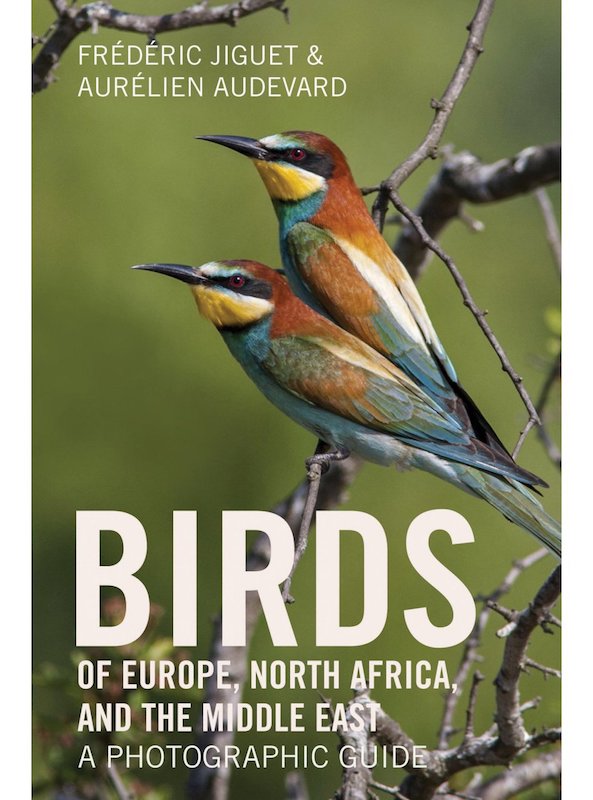Birds of Europe, North Africa and the Middle East – A Photographic Guide by Frédéric Jiguet & Aurélien Audevard | Translated by Tony Williams | Princeton Universtiy Press | Paperback | Feb 2017 | 447 Pages | colour distribution maps | 2,200 Colour Photographs | ISBN: 9780691172439

The Publisher’s View: Birds of Europe, North Africa, and the Middle East is the first comprehensive pocket-sized photographic field guide to every bird species in Europe – this includes winter visitors and common migrants but also all rarities to the region, even if they have been recorded only once. The guide also covers hypothetical species – those that have a good chance of being recorded due to such factors as range expansion and changing weather patterns.
The book’s 2,200 stunning color photographs mean that every species is pictured, making field identification quick and easy. Succinct text covers key identification features, voice, habitat, and distribution, and distribution maps are provided for regular breeding species. Particular attention and details are given to help differentiate similar-looking species.
Lavishly illustrated, up-to-date, and wide-ranging, Birds of Europe, North Africa, and the Middle East is an essential field guide for every naturalist and birder.
Other Views:“This is an excellent photographic field guide. Considering its portable size, the coverage is immense. Practical, handy, and attractive, it will have a wide appeal. “
– Nigel Redman, author of Birds of the Horn of Africa
“The overall look and aesthetic feel of this book is attractive, and its images are well chosen. It will fill a niche in the European birding market and beyond. “– Julian Hough, founding editor of the Naturescape Images blog
The Authors:
Frédéric Jiguet is one of France’s leading ornithologists and a conservation biologist at the Muséum National d’Histoire Naturelle in Paris. He is director of the Centre de Recherches sur la Biologie des Populations d’Oiseaux (CRBPO), and serves on the editorial board of France’s premier bird-study journal, Ornithos.
Aurélien Audevard has been studying birds for much of his life and has conducted several high-profile conservation studies for the Ligue pour la Protection des Oiseaux, Provence-Alpes-Côte d’Azur (LPO PACA). His photographs have appeared in many of Europe’s leading birding magazines, including Ornithos, L’Oiseaux, Birding World, and Dutch Birding.
Fatbirder View:Anyone who knows me or reads my reviews knows I am no lover of photographic field guides. In short line drawings we know are simplifications and allow an easy way to see distinguishing features. Photographs fool us into thinking that what is depicted is in some way definitive. Poor or variable light, an odd angle or colour distortion can change what we see so much it becomes at the least moot and our acceptance of them as real casts doubt. Moreover, most guides to not manage to capture birds in virtually identical poses for comparison. Ok, end of usual anti photo-guide screed. Now for the particular.
These guys have tried really hard to overcome that comparison hang-up and have done pretty well… certainly better than almost every other such guide I’ve see. I like the layout’s similarity to a traditional guide with several small portraits on a page of similar related species along with distribution maps and very succinct text. So far so good.
However, a little background is shown in each shot… I would prefer it to be taken out as it doesn’t help, context, when minimal is not useful and in very small photos obscures. Life is in 3-D, but photos are flat and the whole flat illustration makes concentrating on images and ID features harder. In line drawings we know we are looking at simplified two-dimensional representations. Moreover, just as a landscape artist ignores the telegraph poles in their representation of a scene so the line drawing can miss out the plumage texture and meld colours unless they help us identify a bird or distinguish it from its look-a-like fellow.
Colour is another variable of course and true colour in print is hard to achieve but when a photo colour is so subtly graded over a very small area images can look smudged. What’s more some colours are just plain wrong. In my copy a bird’s white rump, with a label saying ‘white rump’ points to one which is an odd shade of blue.
Having said all this I am impressed with it as the best photo-fieldguide I’ve seen to date. The coverage of All of Europe with N Africa and the middle-east is welcomed too as many holiday where zoo-geography is less delineated than country political borders.
Would I dump my favourite app or painted field-guide? No. Would I take it with me on a trip to Spain or Turkey? Yes. I see this very much as a back-up aid not a replacement. Best of breed as it were, not overall champion.
Buy this book from NHBSFatbirder
